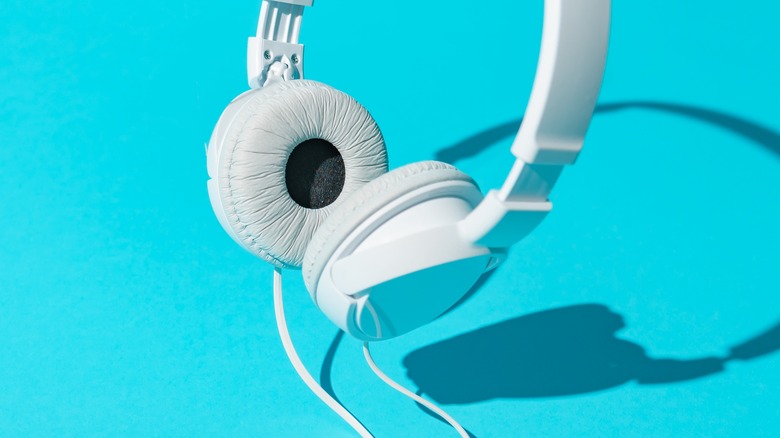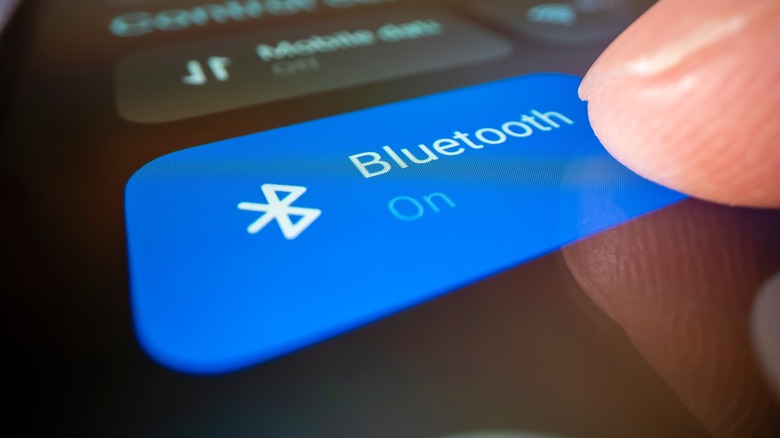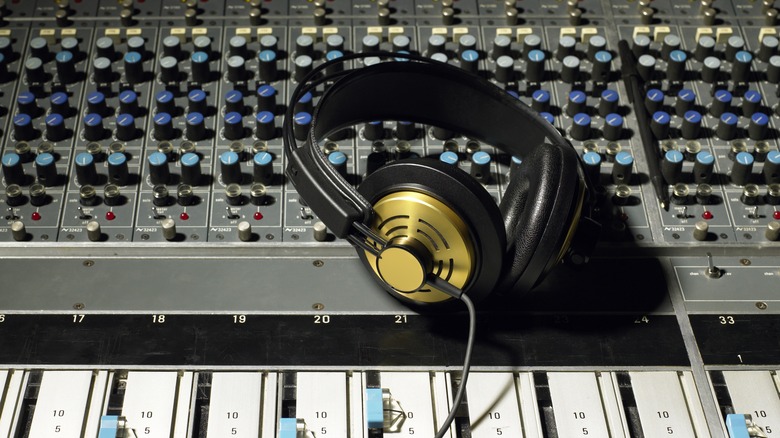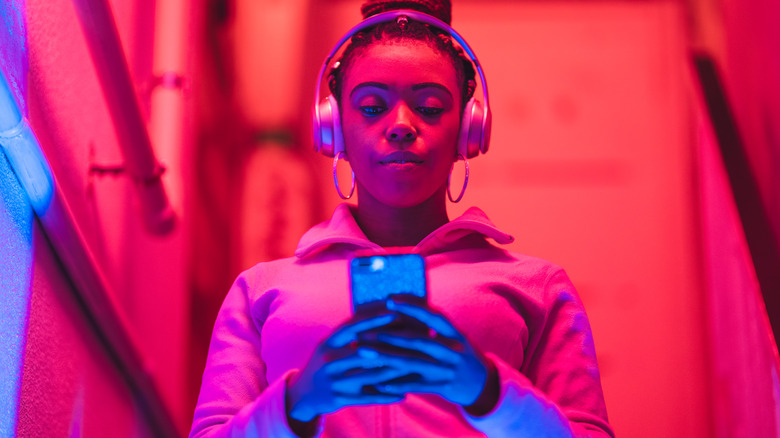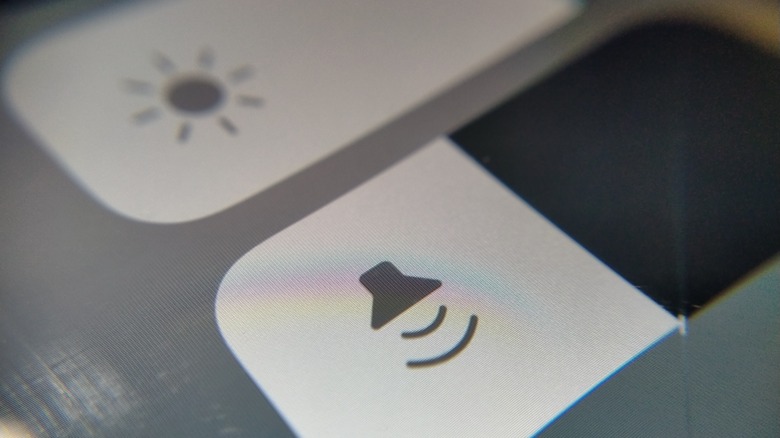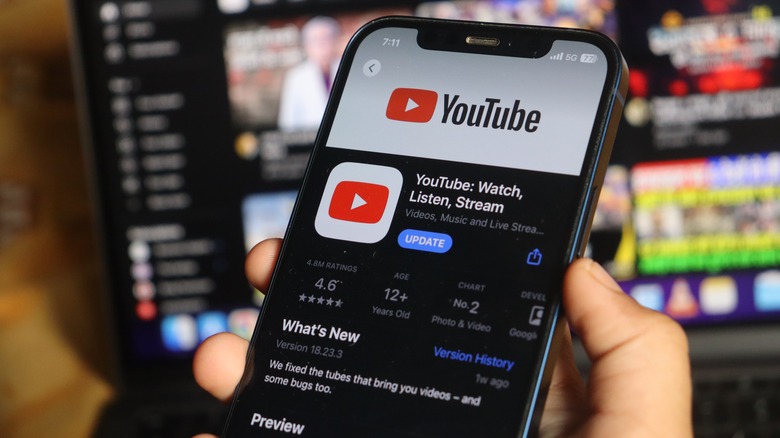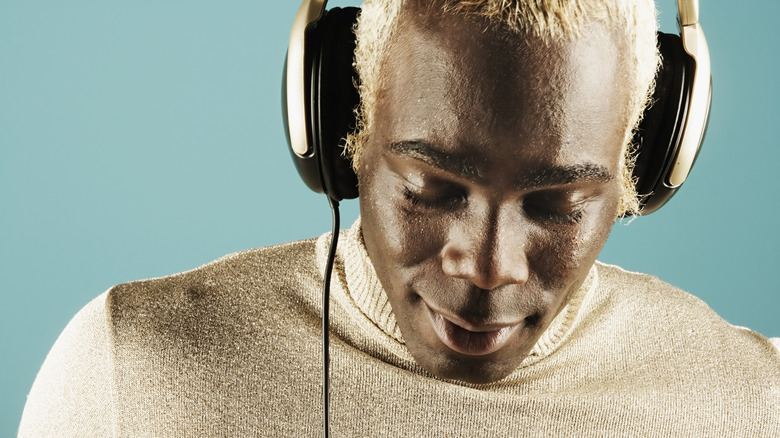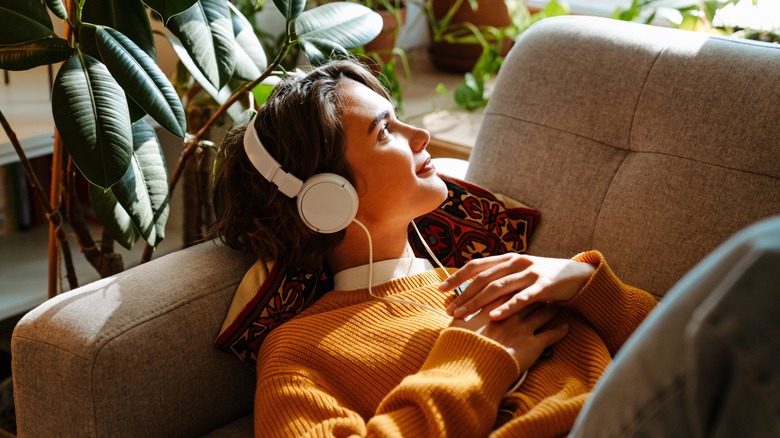Do Wired Headphones Really Sound Better Than Bluetooth? Here's What You Need To Know
Fun fact: Bluetooth has Viking origins. Creator Jim Kardach was inspired by Danish king Harald Bluetooth, famous for uniting his people and conquering Norway. According to National Geographic, Harald got his curious moniker for having a "dark" tooth — the adjective for a dark color in Old Norse also means "blue." Kardach found a use for this historical analogy of uniting or conquering all the different "tribes" and placing them under one "banner," and thus Bluetooth was born. Even the logo is Viking — it's a combination of King Bluetooth's runic initials. Fast forward to today, and the technology is the default wireless audio standard across all devices. It's convenient, takes seconds to set up, and helps you get rid of all those snaggly cables. But the moment you so much as mention buying a pair of wireless Bluetooth headphones, someone is bound to push their glasses up the bridge of their nose and point out, "Yeah, but Bluetooth is worse than wired, actually."
It's a common refrain in online audio communities. Bluetooth compression just ruins your songs, people say, and therefore you should always opt for wired audio devices. Does Bluetooth actually sound worse, though? Taking a closer look, you'll find that this assumption is not as cut and dried as it first may seem. We're here to set the record straight. Let's discuss the truth in the claim, and whether it's worth your money to invest in wireless cans.
How Bluetooth works
To better answer the question, let's do a quick primer on Bluetooth technology, because this stuff is black magic. Bluetooth uses low-power radio waves in the 2.4 GHz frequency band (encompassing 79 channels) to transmit wireless music, send files, control peripherals, print documents, and so much more. The tech operates within a tiny bandwidth between 2.4 and 2.4835 GHz yet can transmit about 3 Mbps (megabits per second). And though its range is typically about 33 feet, it can reach over a kilometer in certain applications.
Where Bluetooth really boggles the mind is how it transmits your data of choice. Once two devices are paired, they share keys so they can recognize each other in the future and keep data encrypted. Then, they do "frequency hopping," switching channels up to 1,600 times per second to avoid signal collisions, reduce interference, and strengthen security against malicious interception. Bluetooth employs codecs to send the data (these determine sound quality and performance), which can be swapped on the fly in response to changing conditions such as physical obstacles and interference.
This is why you can have a half dozen Bluetooth devices working in the same small space that still function just fine alongside Wi-Fi and other radio signals. The technology is also constantly evolving, with new versions improving encryption, range, power efficiency, and stability. But how does it compare to wired headphones?
Wired headphones are technically superior to Bluetooth
Yes, wired headphones, sonically speaking, are better than Bluetooth. Wires are the fastest way to transfer data of any kind, so you can get full, uncompromising, lossless 32-bit sound at 196 kHz — in layman's terms, the best music quality that current tech can reproduce. This allows you to hear music the way the artist intended, almost as if you were there in person. Not a single detail goes missing. Bluetooth can't hold a candle to this — the creme-de-la-creme LDAC codec allows for a max of 32-bit/96 kHz, and that's before accounting for Bluetooth's weaknesses.
Wired headphones also exhibit almost no perceptible latency. Electricity is the speed limit of your sound, which in a wire travels at up to 90% of the speed of light. So, wired headphones — assuming you're not using an amp and/or digital-to-analog converter (DAC) — usually get about 5 milliseconds of latency. Bluetooth gets about 34 to 200 milliseconds depending on the codec and version of the tech you use, primarily due to the audio compression/decompression process. This is noticeable, and though it may not be a problem for music, it can make watching videos (dialogue in particular) bothersome.
Now, this isn't to say wired headphones reign supreme in reproducing sound at all times, in all situations. It's naive to assume that a cheap pair of gas station earbuds is going to outperform anything without a headphone jack. But more on that later.
Bluetooth can produce high-quality audio
There are a lot of caveats when using Bluetooth: Its narrow bandwidth limits the sample rate, bit depth, and bit rate of music files; it suffers unstable data rates from signal interference, physical obstacles, and distance between devices; its psychoacoustic compression algorithms sometimes eliminate (typically imperceptible) data to save space. The point here is that Bluetooth is going to be lossy barring perfect conditions.
Yet Bluetooth can still produce high-quality audio. A common misunderstanding is that codecs always ruin music quality, but this is not necessarily true. If you're using the same codec on both your headphones and audio device, the codec has enough bandwidth for your music files, there's minimal interference, and the units are close, then sound quality should be virtually identical to a pair of wired headphones.
Compression means a lot of things these days (such as YouTube's compression to reduce video size), so it's important to understand how Bluetooth does it. The key word here is "codec," short for compression/decompression. Akin to a .zip file, Bluetooth packages data in a smaller space for the trip and unpacks it at the other end, preserving a song in transit. Audio degradation (aside from the factors we've already mentioned) occurs mostly if you're using two different codecs, which results in an effect similar to re-encoding a lossy MP3 file. So if you're listening to, say, a high-quality 264 kbps AAC file using the AAC Bluetooth codec on wireless headphones, it likely won't sound any worse than wired.
The average person probably won't hear the difference
The core premise of the "Bluetooth is worse" argument tends to be an audiophile one. After all, Bluetooth is, apples to apples, technically worse than wired audio. But does that distinction mean much in the case of real-life use for the average person? Not really. For starters, most people can't even tell the difference between a lossy and lossless audio file. Surveys using A/B tests have shown that only a minority of people can. Even professional musicians (like Benn Jordan) have admitted that they cannot distinguish a high-quality MP3 from a lossless file.
Tests comparing Bluetooth and wired headphones have yielded similar results, suggesting people usually can't differentiate them. Only someone with above-average natural hearing acuity (or rather, ears trained by experience) may find ever-so-slight frequency differences between the two. There's a very good chance that human psychology is at play here. If you've been told for years that Bluetooth is worse and then put on a pair of Bluetooth headphones to listen, you may be unwittingly conditioned to agree with that assessment.
It's important to note here that technology has improved drastically over time. Lossless digital music used to be a night-and-day difference from lossy, but these days compression algorithms are exceptionally good at delivering pristine audio at lower bitrates. The same goes for Bluetooth codecs. Even with all this being the case, let's look at some things you can do to ensure your Bluetooth music sounds its best.
The Bluetooth codec you use is the primary deciding factor
Above all else, the Bluetooth codec in your headphones and listening device will determine how good your sound is. There are many to choose from — SBC, AAC, aptX, LDAC, and more — and your devices automatically choose and switch codecs for the best balance of quality and connection strength. If you want to select them yourself, though, you can. If you're using an Android, you have to enable developer options. Unfortunately, most other platforms like iPhone, Mac, and Windows won't easily let you.
Not all codecs are equal, so going with the default may not ensure the best audio quality. SBC, the baseline codec available on almost all devices, tends to produce the lowest-quality audio of the bunch at 328 kbps max. LDAC, on the opposite end of the spectrum, has a variable bitrate that can reach 990 kbps. In simpler terms, that's two-thirds of the way to CD quality. It goes without saying you should choose LDAC if precision, hi-fi audio is your aim.
Then there's the issue of compatibility. Not all headphones and devices support all codecs. iPhones, for example, only support AAC, as does Apple's Bluetooth AirPods lineup. Even Sony's top-of-the-line XM5 only supports SBC, AAC, and LDAC. Remember: Using two different codecs will cause data loss and spoil your audio quality, so you should check to ensure both your streaming device and headphones are on the same page. Changing codecs manually, as we've mentioned, tends to be difficult unless your headphones app allows it.
A bad audio source results in poor quality regardless
Even if you've optimized your Bluetooth to use the best codec possible, it will mean nothing with a shoddy source. As the saying goes, garbage in, garbage out. Take YouTube, for example, a way many people listen to free music. You might be quick to blame your Bluetooth headphones for spoiling your YouTube music playlist, but the true culprit would be YouTube's comparatively low 126 kbps bitrate.
Suppose that you pay for a streaming service like Spotify. If you don't have its lossless HiFi plan, the service won't necessarily provide high-quality audio. Spotify's "very high" option with the standard plan (which streams at 320 kbps) isn't enabled by default, and many people leave it off to avoid eating up their mobile data. So if you listen to Spotify at default settings, you're getting a measly 160 kbps — again, Bluetooth is not the weak link here.
If you're hell-bent on having the best wireless audio experience possible, load up your listening device with lossless audio files such as FLAC and make sure your phone is using a high-bitrate codec like LDAC. All things considered, you'll probably be fine with a 320 kbps MP3 file, and you'll save space on your mobile device as well. Premium streaming services like Spotify and Apple Music also let you download music offline so you don't have to worry about your audio quality automatically downgrading when the cell signal is bad.
Sound quality depends in great part on your headphones
At the end of the day, using Spotify's HiFi lossless streaming tier won't mean a thing if you go with those no-brand gas station earbuds that cost all of $5. You want the best audio quality? You'll need to invest in the gear that can provide it. While there are audiophile headphones for sub-$100, many easily approach $2,000 and beyond. The point is that music quality is more dependent on headphone engineering than on wired versus Bluetooth.
Generally speaking, better headphones are more forgiving of Bluetooth's deficiencies. High-end Bluetooth headphones like Sony's WH-1000XM5 or Bose's QuietComfort Ultra will bring out the best even a lowly MP3 using the SBC codec has to offer — though you'll have to pay through the nose to get them. If you can't (or don't want to) shell out almost $400, then there are plenty of wonderful budget-friendly alternatives. Keep in mind that many Bluetooth headphones include ANC (active noise canceling) to remove unwanted ambient sound. This ANC may alter music quality ever so slightly, especially for more perceptive listeners, and degrade your Bluetooth listening experience. Try switching off your headphones' ANC if the sound quality seems insufficient.
And in truth, headphones aren't even the gold standard among audiophiles since most treat speakers as the end game. If you're looking to headphones as the solution for an unparalleled listening experience, you're going in the wrong direction.
Your listening environment will impact Bluetooth quality
Wired headphones sound the same everywhere. As we've previously established, Bluetooth's limited bandwidth means it's always at risk of interference from other radio sources and physical obstacles that impede its signals. The average home is full of Bluetooth-disrupting radio sources like smart TVs, Wi-FI routers, appliances, and more. Even if you've only got typical gypsum walls, they'll still serve as hurdles for Bluetooth.
Leaving your house, you'll likely be using your wireless headphones in areas packed with radio signals and physical obstructions, like a busy mall or a crowded public subway train. Don't forget that Bluetooth operates on only 79 channels, so imagine the challenge when you have just a couple dozen Bluetooth devices in close proximity. Of course, the FCC is working to widen the spectrum of unlicensed bands (frequencies any device can use), so this problem may be mitigated with time.
The distance between your headphones and streaming device will also impact sound quality. Suppose you leave your phone in one room and go into another. It won't be just the walls causing intermittency and poor audio quality — these issues will crop up the closer you get to a maximum recommended distance. To sum up, Bluetooth users pay for the convenience of audio quality that depends heavily on their environment. If you want the best wireless audio quality, you'll need to get away from the places that ruin it.
Wireless music can already be lossless
Bluetooth may never be able to produce lossless music, but that doesn't mean that wireless music as a whole is a lost cause for audiophiles. In fact, you can listen to lossless music wireless right now — if you have the right gear. Qualcomm's Snapdragon Sound with aptX Lossless bypasses Bluetooth's limitations by sending the music over Wi-Fi instead. Wi-Fi is broad enough that aggressive compression isn't necessary, so the only compromise you'll be making is slightly increased battery consumption.
aptX Lossless is in its infancy and is only supported on about 45 Android phones at the time of this writing — none of which are made by major manufacturers like Samsung and Google Pixel. Only Qualcomm Snapdragon-chipped devices can run it, and less than a dozen headphones and earbuds are currently able to decode it. Apple users who own the AirPods 2 Pro (USB-C version) may get Apple's own proprietary lossless, wireless audio sometime in 2024, though only on the costly Vision Pro at first. We don't have any news on when it will hit other devices. To be fair to wireless audio, this is brand-new tech just barely dipping its toes in consumer markets. There's good reason to hope this standard will see major improvements in the coming years alongside more widespread adoption.
Taking a different approach
It's time to take a step back and look at this discussion from a bird's eye view. At the end of the day, music is a highly subjective thing. Audiophiles (like elitists in any community) often make the mistake of assuming that their high standards apply to the world at large. They don't. Most people listen to music on whatever headphones are readily available, in noisy environments, often with their attention divided. These circumstances are not conducive to hearing music at its best, so adding Bluetooth on top won't make a difference.
As we've demonstrated, Bluetooth can produce high-quality audio, so when people say "Bluetooth is worse," they're not just oversimplifying in a way that's not true. They're also making an argument that's been spearheaded by marketers in the music gear and music streaming industries. Companies exploit the feeling that we're missing out on sound at its best and convince us to spend hundreds of dollars on equipment and software to rectify the situation. Yet many audiophiles know from experience that you can spend thousands of dollars on equipment and never get to a point where you're satisfied enough to stop.
People listen to music for enjoyment. They like their music whether it's on those gas station headphones or a $20,000 pair of speakers. Our suggestion is this: Listen to music however you like. Don't get too hung up on the technicalities between wired and Bluetooth headphones.
How to decide on the best headphones for you
It's pretty clear at this point that Bluetooth versus wired shouldn't be the linchpin of your headphone purchasing decision unless you're a sound engineer, professional musician, or audiophile. Instead, focus on what makes music listening enjoyable and what fits your budget. If Bluetooth comes into the equation, let it be for added convenience (or lack thereof, since it's another device to charge) rather than a compromise in the audio department.
The most important thing you can focus on is fit and weight. A good pair of headphones shouldn't put too much pressure on your ears, get too hot in the cups, or lead to neck strain. Avoid headphones with an over-tight band — especially one that digs into the top of your head — or you'll probably experience headaches. The second most important thing is finding a frequency response you like. Most enjoy the Harman curve, but your mileage may vary. After that, consider useful features. Look for cans that fold up for transport or come with a removable cable.
A good reason to buy Bluetooth is ANC (active noise canceling), which is ideal for protecting your hearing in our noise-polluted cities. You may also have to bite the bullet if your phone lacks an audio jack, though a good USB-C dongle is an easy solution. Apple users with multiple devices will love AirPods for ecosystem benefits like fast, automatic device switching. Simply put, make the decision that's best for you.
